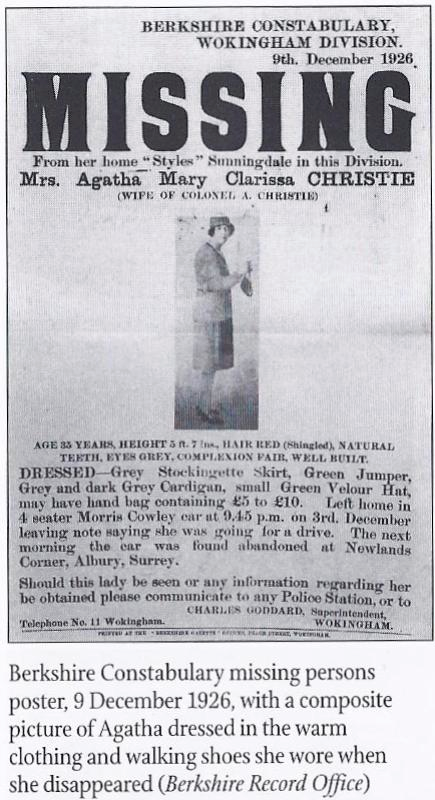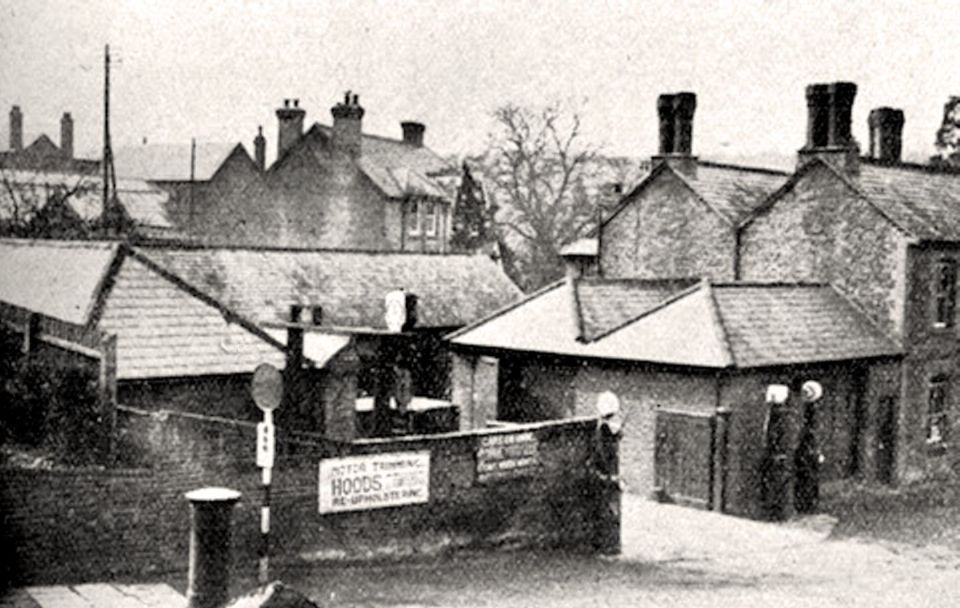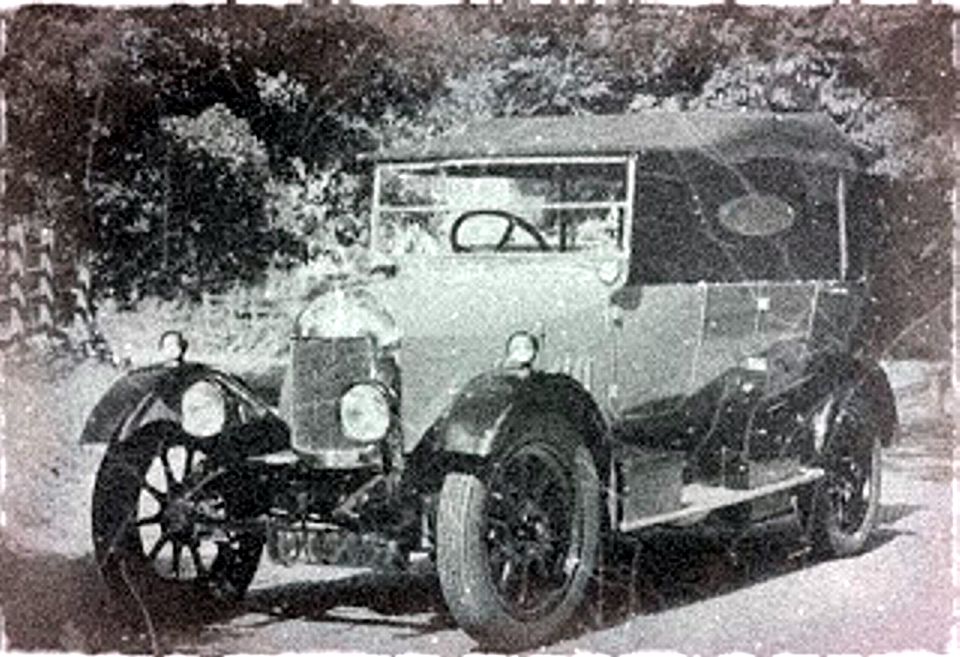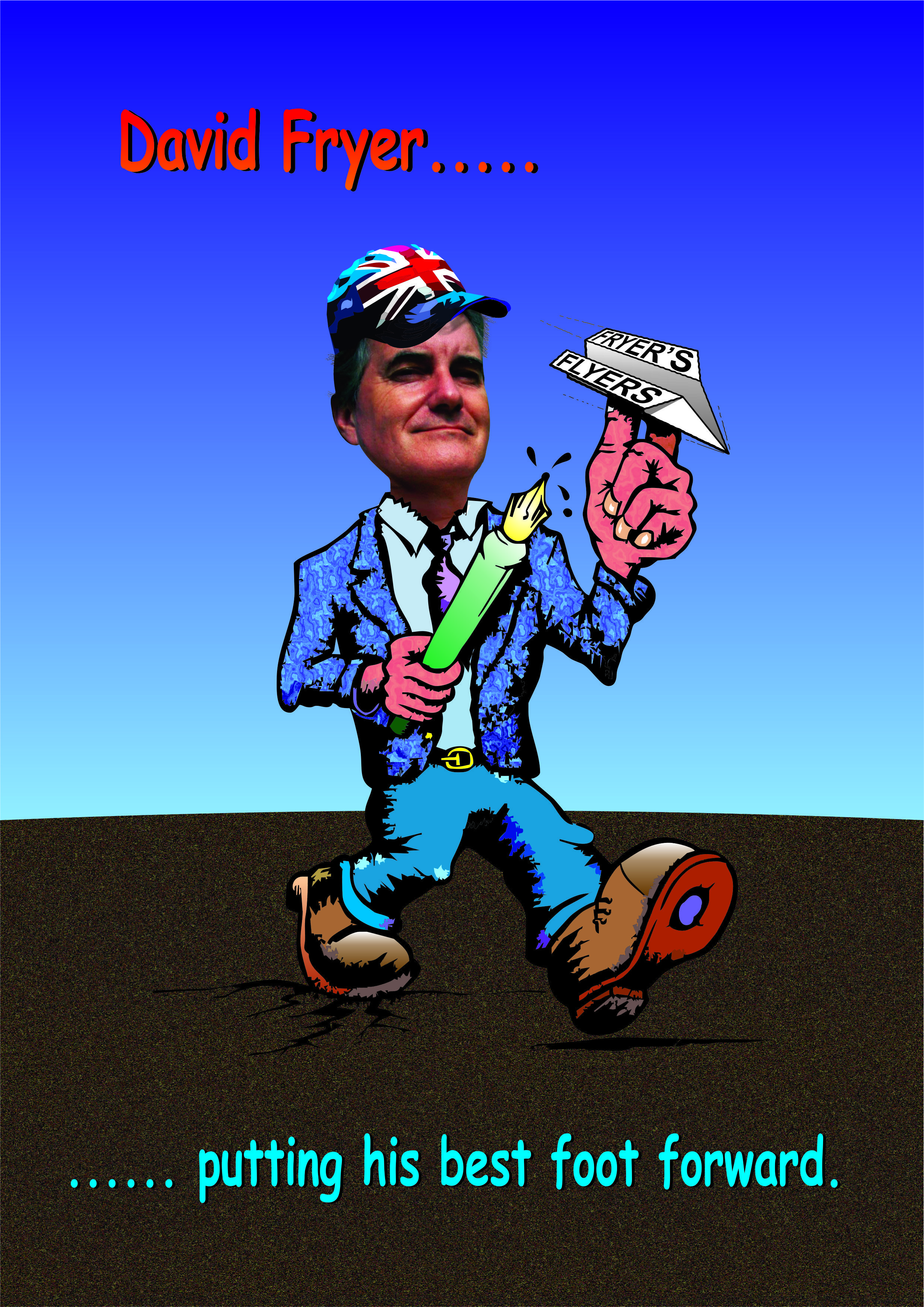AGATHA CHRISTIE and the MYSTERY OF THE MISSING MORRIS
David Fryer
“I will confess here and now that of the two things that have excited me most in my life, the first was my car: my grey bottle-nosed Morris Cowley. The second was dining with the Queen at Buckingham Palace about forty years later.”
Agatha Christie in her autobiography, 1977
When Agatha Christie mysteriously disappeared on the night of Friday December 3rd, 1926, the incident made headline news in British newspapers and front page coverage in the New York Times. Her disappearance triggered an unprecedented search that involved over 1000 police, teams of tracker dogs, more than 15,000 volunteers, spotter planes, a renowned clairvoyant, and distinguished crime writers Sir Arthur Conan Doyle and Dorothy L Sayers.
The intensive search initially centred on her beloved Morris Cowley tourer which was found abandoned not far from Silent Pool – a haunted spring-fed lake and popular beauty spot in Surrey that Agatha Christie had used for her novels. A passer-by, Jack Best, stumbled upon the damaged Cowley early on Saturday morning when he was walking his dog. The car was grounded on a grassy embankment with its rear wheels in the air, the driver’s door was open, the lights were still on, and clothes were scattered over the rear seats. Personal items, including an expired driving license, were also found at the scene.
Teams of police and tracker dogs searched the surrounding countryside for days and thousands of volunteers scoured every bush and bramble in tight coordinated lines. Spotter planes were used for the first time and the lake was dragged for a body, but nothing was found. Sir Arthur Conan Doyle and Dorothy L. Sayers joined the search and a prominent clairvoyant was handed one of Agatha’s gloves, but all to no avail. The world’s most famous author had disappeared without trace and millions of devoted fans suddenly found themselves transfixed by a real-life murder-mystery that could easily have been lifted from the pages of her best-selling novels.

Suspicion initially fell on Agatha’s husband, Archie, who had spent the weekend with his mistress, Nancy Neele, but with a rock-solid alibi and lack of hard evidence, he could not be charged. Questions were asked by leading politicians and a substantial reward was offered by a major newspaper, but the case remained unsolved.
Silent Pool was dragged for the second time on the 7th December and an adjoining millstream was drained of water. Then a letter was discovered, supposedly written by Agatha Christie herself. It claimed she had gone to a Yorkshire spa for a rest, but the letter was discounted by police. Little did they know it was the most important lead they had.
The famous author was finally discovered on the 14th December at an up-market spa-hotel in Yorkshire. She had registered herself at the Swan Hydropathic Hotel in Harrogate (now the Old Swan Hotel) under the pseudonym of Mrs Teresa Neele from Cape Town. The chosen surname was obviously inspired by Archie’s lover, Nancy Neele, and one observer even suggested the name Teresa was an anagram of Teaser.
Her fans were less than sympathetic when they heard the news. Many were outraged by the waste of police resources and there were suggestions the whole thing had been staged as an elaborate hoax to generate publicity for her latest novel. The official response, from Colonel Christie, was that she was suffering a combination of amnesia, nervous tension and depression, after the loss of her mother earlier that year. He didn’t mention the affair.
The Christies separated soon after and eventually divorced in 1928. Archie married his lover, Nancy, and Agatha took custody of their daughter, Rosalind. The Christie name was retained for her writing and she went on to become the most successful crime-writer of all time. The Guinness Book of World Records claims she has sold over two billion copies of her novels and her estate boasts that she is third in the rankings of most-published books after Shakespeare and the Bible.
Her disappearance inspired several books, a feature film, doco-dramas, radio broadcasts, numerous articles, and even a Doctor Who episode. At least one book – Agatha Christie and the Eleven Missing Days by Jared Cade – became a best-seller in its own right. A feature film – Agatha – followed in 1979 starring Vanessa Redgrave, Dustin Hoffman and Timothy Dalton. A BBC TV doco-drama – A Life In Pictures – screened in 2004 and, in 2008, a Doctor Who episode – The Unicorn and the Wasp – travelled back in time to the fateful night she disappeared. It featured Christie in a blue Bullnose Morris shortly before she was taken away in the TARDIS and transported to the hotel in Harrogate!
Agatha Christie avoided discussion of the incident for the rest of her life and there was no mention of it in her autobiography. (The autobiography was published in 1977, shortly after her death).
As for the fate of Agatha Christie’s beloved Bullnose Cowley, therein lies another mystery. While the author’s disappearance has been heavily documented with forensic attention to detail, information on her car is almost non-existent. There are no published photos, no documents, no registration number, and very few details other than an occasional mention in her autobiography and interviews. This is surprising because it was a significant feature in her life and pivotal in police investigations at the time.
The Daily Mail devoted several pages to the incident in 1926 and they still hold a number of original photos in their archives, but none show a Morris Cowley. It would appear the car was removed by the police and sent to Sanford Garage in Guildford, presumably before the press were alerted. Some damage was recorded by an employee in the Surrey Advertiser at the time:
“The bonnet was slightly damaged, the speedometer cable broken, and the wing a little bent. The electric battery was run down.”
According to a 1927 directory, the garage – at 60 Epsom Road – was run by a man with the unlikely name of Captain Napper. The garage was redeveloped in the Art Deco style a few years later, but it was still used as a garage for several decades. An additional two residential floors were added more recently – in matching Neo-Deco style – and called Sanford Mews. The garage is now a bicycle store.

Sandford garage in the 1920’s
The Guildford Dragon – a weekly on-line newspaper – ran a mystery photo competition in July 2013 called ‘Where Is This?’ (No.64) featuring the original garage c1922. It was correctly identified by a number of readers, but there was no mention of the important link to Agatha Christie in either the editorial comment or responses. The editor-owner is also a historian and lecturer in history, but he was unaware of the important link. Sadly, it would appear this little morsel of local knowledge has withered over the years.
Her difficulty in starting the car early that morning in 1926 was reported by a pit worker, Edward McAllister:
About 6.20 on Saturday morning I saw a motor car with a woman standing at the back. She said to me: ‘Would you mind starting up my car for me please?’ I said: ‘I will have a try.’ I got off my bicycle and started up the car after some little trouble. The radiator was cold and the lights of the car were on. The Surrey Advertiser, 1926.
The Cowley had evidently been out in sub-zero conditions all night and the woman’s hair was allegedly covered with hoar frost. This report ties in nicely with the car being discovered approximately two hours later with the lights still on near Newlands Corner. Some reports claim the car was found overhanging a chalk pit, but this is an exaggeration.
Christie wrote about the challenges of starting the Cowley in her Autobiography (p.349):
“I cranked and cranked, and nothing happened. Finally, I burst into tears, came into the house, and lay on the sofa sobbing.”
This happened not long after her mother died in the spring of 1926 and it may indicate that she was struggling emotionally at the time.
Christie also wrote about the challenges of learning to drive in an earlier reference (p.332):
I don’t think I can really reverse at all, the car never seems to go where I think it’s going.” Her first attempt to drive Archie – to a train station on the western outskirts of London – was “…..one of the worst ordeals I have ever known.”
It was Archie who reminded her that she knew how to put the brake on because that was the first thing he had taught her.
“I was shaking with fright” she said, “I stalled the engine once or twice by braking rather more violently than I need. As long as you could steer reasonably, and didn’t have to park, turn, or reverse too much, all was well.”
These statements paint a fascinating picture of a young woman learning to drive in the 1920’s, but the lack of specific detail has led to speculation over the years: Does the Cowley still exist? Or was it scrapped like so many other vintage cars after WW2?
A comprehensive search of the internet yielded a bewildering number of articles on Agatha Christie’s disappearance, but hardly any information on the Cowley. Several sites feature an image of a car purporting to be the genuine article, but all such claims turned out to be incorrect or deliberately misleading.
While some show a Bullnose Morris of appropriate vintage, other claims are blatantly absurd. One site hosts an image of a later ‘Flatnose’ Cowley claiming to be her car, yet these didn’t appear until after Agatha Christie’s disappearance. Another site shows an Austin Seven, while several sites – including Alinari and Getty Images Inc.- show a copyright-protected photo of an impressive veteran landaulet claiming to be the actual abandoned car on the day. But the vehicle is a much earlier pre-1915 Dennis with a Midlands registration mark. The interesting thing about this car, other than its rarity, is that Dennis had a factory in Guildford, just down the road from where Agatha Christie disappeared. The Dennis was used by the police for their reconstruction of events a few days after her disappearance and it may have been supplied by the factory. (Getty eventually corrected their image, but Alinari have yet to amend theirs).
Just one solitary image appeared to be genuine, at least at first glance. The tatty sepia photograph shows a 4-seater Morris Cowley of the same vintage, but something wasn’t quite right. Agatha Christie disappeared in December, the depth of winter in Britain, and the image clearly shows trees in full leaf with bright sunshine. Was this an earlier photo from the Christie archives? Sadly no. The image bore a striking resemblance to a colour photograph of the late Garnons-Williams Bullnose used in Jared Cade’s recreation of the fateful drive in 1926. The two images were compared side by side and, sure enough, the sepia photo is nothing more than a PhotoShop forgery. (It should be noted that Jared Cade was unable to provide any information on this image and there is no suggestion he had anything to do with the forgery).

The fake Cowley
So, why are there no images of the Christie Cowley? A woman driving a car was something of a novelty in 1924 and a famous woman driving a car would have attracted considerable attention. The lack of documentation or photographic evidence has generated speculation over the years as to the exact model. The Daily Mail described the car as a two-seater in 1926, yet the BBC mention a coupé in their 2004 documentary. The most compelling description can be found on a Berkshire Constabulary wanted-persons poster issued on December 9th, 1926 where it is described as a 4 seater Morris Cowley. (An original poster can be viewed at the Berkshire Record Office, document reference PS/FT26/29).
Agatha Christie confirms this in a brief description of driving in Devon in 1930 (Autobiography p.415):
“I used to drive my faithful Morris Cowley, which was of course an open touring car, and which had an elderly hood with several gaps in its structure, so that, sitting in the back, water coursed steadily down the back of your neck. In all, going for a picnic with the Christies was a distinct endurance test.”
She met Max Mallowan, a renowned archaeologist, at this time and they married soon after.
The search for the missing Morris continues next month.
© David Fryer, March 2015
The Mystery of the Missing Morris, Part-2:
“The last thing I dreamed of was a car. Nobody I knew of in our circle of friends had a car. I was still imbued with the notion that cars were for the rich.”
Agatha Christie discussing the possibility of buying her first car in 1923. (From her autobiography, 1977).
Agatha Christie has been the subject of intense public scrutiny for over nine decades. Countless books and articles have been written, films and documentaries have been made, hundreds of photographs have been published, yet very little has been written about her beloved Morris Cowley; no photos of the car have been published, and the registration details are unknown. Does the car still exist? Or was it scrapped a long time ago? To date, these questions have not been answered, which is surprising considering the importance of this humble little car to the world-famous author. If the existence (or fate) of Agatha Christie’s Morris Cowley can be established, more information will need to be uncovered. In the absence of published documentation, other methods need to be explored.
The year of purchase and location is always a good starting point, but without documented reference these pointers have been subject to speculation. There are no specific dates mentioned in Agatha Christie’s writings or interviews, but her autobiography offers some useful clues (p.331):
“Anna The Adventuress had now appeared in the Evening News and I had bought my Morris Cowley – and a very good car it was: much more reliable and better made than cars are nowadays. The next thing I had to do was to learn to drive it.” she wrote. “Almost immediately the General Strike was upon us, before I had had more than about three lessons with Archie.”
The General Strike was a significant event in England lasting nine days, from the 4th May to the 13th May, 1926. This would suggest a purchase date of 1926, but Anna the Adventuress is a 1920 silent film written by Blanche McIntosh and E. Phillips Oppenheim. Anne the Adventurous was a serialised adaption of her fourth novel, The Man In The Brown Suit, which first appeared in the London Evening News in November 1923. The novel was published in book form by her publisher, The Bodley Head, in 1924.
The suggestion of 1926 car is contradicted by a description of driving into the garage at their rental home ‘Scotswood’ in an earlier quote (p.332):
“I had to turn into Scotswood and get myself into an extremely narrow garage, next to our neighbour’s car. These people lived in the flat below us – a young couple called the Rawncliffes.”
The wife reported the ordeal to her husband:
“I saw the first floor driving back this morning. I don’t think she has ever driven a car before. She drove into that garage absolutely shaking and white as a sheet.”
Scotswood is the name of their first house at Sunningdale in Berkshire (they rented the first-floor apartment). The Christies moved there from London in 1924, so this statement confirms she had a car then. They bought a house nearby in 1926 and named it ‘Styles’ after her first book – The Mysterious Affair At Styles. Fortunately, for Agatha Christie, Styles had a two-car garage complete with chauffeur’s quarters. Unfortunately, it also had a history of delivering bad luck to its occupants and the Christie’s were no exception. Within months of moving in Agatha’s mother died, Archie broke the news of his affair, and her disappearance occurred soon after.
Then there’s this quote from an interview with the Sunday Times in 1960:
“My third book was serialised in a newspaper and they gave me a whole £500 for that; it was wonderful. I bought a thing that I thought I would never have – a car, a Bullnose Morris. That is one of the big thrills of my life, a Bullnose Morris.”
It’s interesting to note that she talks about a ‘Bullnose Morris’ in 1960 and a “bottle nosed Cowley” in 1977. Her third book is listed as The Murder On The Links, a title that may have been inspired by Sunningdale Golf Course, for it was this course that influenced Archie Christie’s desire to move there. The Man In The Brown Suit (that inspired the serialisation) was actually her fourth book.
Most London registration records were destroyed a long time ago, so if the Cowley was purchased in London in 1923 /24 – where the Christie’s had owned a number of properties – details are unlikely to be found. They moved to Berkshire in 1924 and the Berkshire County records still survive in original card form. Naturally, a search was commissioned, but nothing turned up. That said, a number of cards list a Sunningdale garage rather than the actual owner. The DVLA – Driver and Vehicle Licensing Agency – were happy to release any details as a matter of public interest, but with literally millions of cars recorded they can only search by registration number. Pity.
A breakthrough of sorts finally came after months of searching when an original image was discovered in a photo-library. The image, captioned a 1925 Morris Oxford with two well-dressed women, was something of a Eureka moment, for there was a young woman who bore a striking resemblance to Agatha Christie herself.
Apart from the remarkable similarity and the Bullnose Morris, there are two further clues in this photograph: The standing woman is wearing a very distinctive fur coat (a fur coat was reportedly found in the abandoned Cowley), and she is also wearing a hat that appears to be identical to one she wore on a world tour in 1923.
The Morris Oxford is similar in appearance to a Cowley, but it has a slightly larger engine and radiator. For someone lacking confidence in their driving skills, the smaller Cowley may have been less threatening.
If it is Agatha Christie, who is the other woman at the wheel? Was she a friend? Did she influence Agatha in her choice of car? Or was she a sales demonstrator? Stewart and Arden were the largest distributors for Morris in the 1920’s and they employed female demonstrators, but the Oxford has muddy tyres with low air pressure and cars used for demonstration were always kept spotlessly clean and in good working order.
So, what is the likelihood of the Christie-Cowley still surviving after nine decades? Almost 33,000 cars rolled off the Morris production line in 1924 alone and relatively few survive today. The search for a registration mark continues, but the mystery of the missing Morris endures for now. Agatha would no doubt be amused to hear that.
It’s worth noting the research for this article was done from a remote location on the other side of the world. That has to be a tick for technology.
Finally, a quote from the remarkable lady herself:
“I don’t think anything has given me more pleasure, more joy of achievement, than my dear bottle-nosed Morris Cowley.”
© David Fryer, March 2015
The author would like to thank the following for their help:
Ann Laver (Agatha Christie’s Surrey, A Research Paper 2013), Surrey History Centre, Reading Archive Office, Beaulieu Motor Museum, Heritage Motor Museum, The Bullnose Morris Club (UK), Thames Valley Police, The Daily Mail Archives, and many others who have contributed in no small way.
Some tit-bits of trivia:
The Guinness Book of World Records lists Agatha Christie as the best-selling novelist of all time.
Over two billion copies of Agatha Christie’s novels have been sold worldwide.
The Mousetrap is the longest running play of all time.
Agatha Christie books rank third, after Shakespeare and the Bible, as most widely-published.
The Christie’s Sunningdale property had a two-car garage and chauffeur’s quarters.
Archie Christie drove a Delage.
The New York Times claimed Agatha Christie was American, but she was born in Devon and was quintessentially British to the core. However, she did have an American father.
A little bit of Bull:
The Morris Cowley badge features an ox fording the River Isis, hence the name ‘Bullnose’.
Isis is the name given to a section of the River Thames above Iffley Lock near Oxford.
The Bullnose radiator is renowned for overheating because of its curved shape.
The radiator shell is made of solid nickel, so you can keep polishing ‘til you hit hot water.
With 33 grease nipples requiring attention each week, the Cowley requires considerably more maintenance than today’s cars.
Every replacement part had a unique Morris name: BEMAH – Rear Wing (£1/3/2d), BOJU – Hood (£1/7/0d), ENASASUCK – Ignition Switch (2/6d), FAGEND – Steering Yoke (2/0d), BABEGAS – Radiator Badge (2/5d).
The Bullnose Oxford inspired Cecil Kimber to set up Morris Garages, better known as ‘MG’.
The first MG was essentially a rebadged Morris Oxford.
The Rajah of Perlis had a suitably enhanced 1925 Cowley.
References:
An Autobiography, Agatha Christie, 1977
The Bullnose and Flatnose Morris, Jarman and Barraclough
Agatha Christie’s Surrey, Ann Laver
Eleven Missing Days, Jared Cade
The Daily Mail, December 1926
The Surrey Advertiser, December 1926
